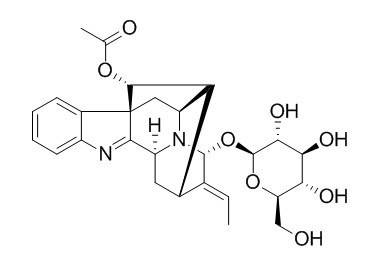Raucaffricine
Reference standards.
Inquire / Order:
manager@chemfaces.com
Technical Inquiries:
service@chemfaces.com
Tel:
+86-27-84237783
Fax:
+86-27-84254680
Address:
1 Building, No. 83, CheCheng Rd., Wuhan Economic and Technological Development Zone, Wuhan, Hubei 430056, PRC
Providing storage is as stated on the product vial and the vial is kept tightly sealed, the product can be stored for up to
24 months(2-8C).
Wherever possible, you should prepare and use solutions on the same day. However, if you need to make up stock solutions in advance, we recommend that you store the solution as aliquots in tightly sealed vials at -20C. Generally, these will be useable for up to two weeks. Before use, and prior to opening the vial we recommend that you allow your product to equilibrate to room temperature for at least 1 hour.
Need more advice on solubility, usage and handling? Please email to: service@chemfaces.com
The packaging of the product may have turned upside down during transportation, resulting in the natural compounds adhering to the neck or cap of the vial. take the vial out of its packaging and gently shake to let the compounds fall to the bottom of the vial. for liquid products, centrifuge at 200-500 RPM to gather the liquid at the bottom of the vial. try to avoid loss or contamination during handling.
Evid Based Complement Alternat Med.2022, 2022:3483511
J Ethnopharmacol.2017, 206:73-77
Evid Based Complement Alternat Med.2021, 8855980.
Tumour Biol.2015, 36(12):9385-93
Curr Res Food Sci.2024, 9:100896.
LWT2021, 138:110397.
Food Chem X.2024, 24:101989.
Cell Death Discov.2023, 9(1):350.
J Integr Plant Biol.2023, 13564.
J Ethnopharmacol.2024, 324:117775.
Related and Featured Products
J Enzyme Inhib Med Chem. 2015 Jun;30(3):472-8.
Ligand structures of synthetic deoxa-pyranosylamines with raucaffricine and strictosidine glucosidases provide structural insights into their binding and inhibitory behaviours.[Pubmed:
25140865]
METHODS AND RESULTS:
Insight into the structure and inhibition mechanism of O-β-d-glucosidases by deoxa-pyranosylamine type inhibitors is provided by X-ray analysis of complexes between Raucaffricine and strictosidine glucosidases and N-(cyclohexylmethyl)-, N-(cyclohexyl)- and N-(bromobenzyl)-β-d-gluco-1,5-deoxa-pyranosylamine. All inhibitors anchored exclusively in the catalytic active site by competition with appropriate enzyme substrates.
CONCLUSIONS:
Thus facilitated prospective elucidation of the binding networks with residues located at <3.9 Å distance will enable the development of potent inhibitors suitable for the production of valuable alkaloid glucosides, Raucaffricine and strictosidine, by means of synthesis in Rauvolfia serpentina cell suspension cultures.



